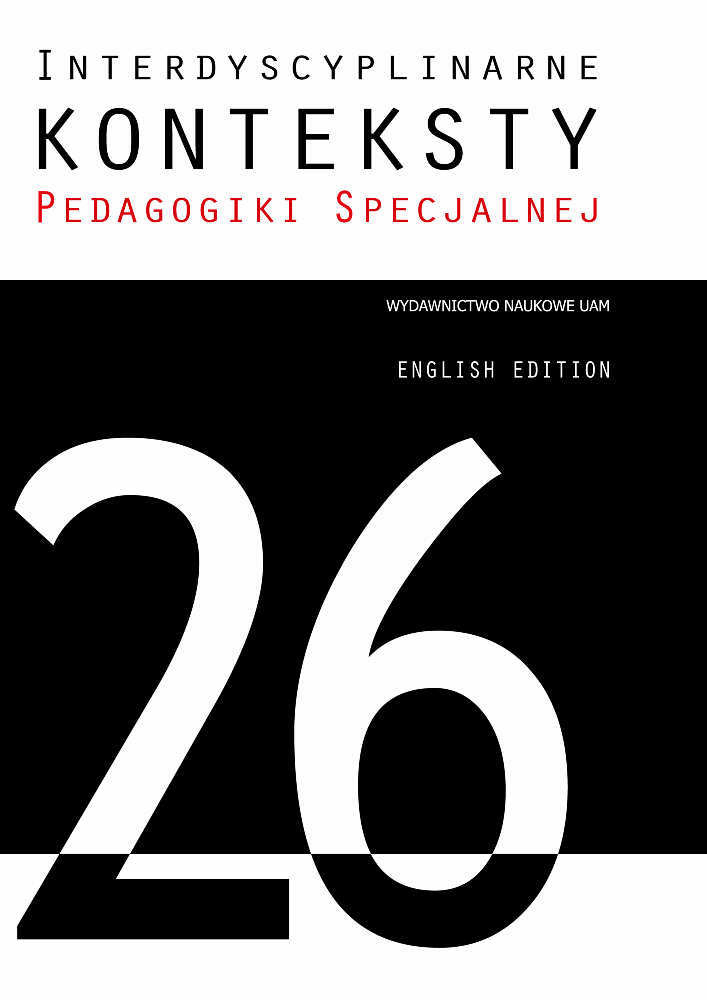Abstract
Hanna Krauze-Sikorska, Children and adolescents with a chronic condition in the public school space – in search of an effective model of psy-chopedagogical support. Interdisciplinary Contexts of Special Pedagogy, no. 26, Poznań 2019. Pp. 205–318. Adam Mickiewicz University Press. ISSN 2300-391X. e-ISSN 2658-283X. DOI:https://doi.org/10.14746/ikps.2019.26.14
Chronic condition may, in time, become a specific kind of „stigma” that determines the formation of a specific “conveyor belt” which determines the trajectories of the fate of children and adolescents. Analysing the functioning of children and adolescents with a chronic condition, for which the school should provide (as for other students) the conditions of learning, both in the cognitive and in the directional aspects, one may indicate not only the imperfections of educational activities, but also a myth of noble ideas inscribed in the function of school, as a place of universal development of every student. The article is a proposal of employing, within the process of educating children and adolescents with a chronic condition, an eclectic model of activities, based on their complexity and sequentiality. The model refers to models proposed by Frederick C. Thorne, or Richard James, used in situations of crisis intervention: the equilibrium model, the cognitive model, and the social change model.
References
Bąbka J., Nie integrować nadmiernie, „Edukacja i Dialog” 2002, no 1, pp. 3–10.
Bowen M., Thomson J., Nie wystarczy tam tylko być, [in:] Integracja dzieci o specjalnych potrzebach edukacyjnych. Wybrane zagadnienia etyczne, (ed.) G. Fairbairn, S. Fairbairn. Warszawa, CMPP-P, 2000.
Dąbrowiecki P., Kupryś-Lipińska I., Łęcka D., Raport, Astma ciężka. Sytuacja pacjentów w Polsce POCHP, Wyd. Novartis; 2015, <https://www.astma-alergia-pochp.pl/download/Raport_Astma_Ciezka_maj%202015.pdf> [access: 19.05.2019].
Deklaracja z Salamanki oraz wytyczne dla działań w zakresie specjalnych potrzeb edukacyjnych przyjęte przez Światową Konferencję Dotyczącą Specjalnych Potrzeb Edukacyjnych: Dostęp i Jakość, Salamanka, Hiszpania 7–10 czerwca 1994 r., UNESCO 1994.
Dudzikowa M., Mit o szkole, jako miejscu wszechstronnego rozwoju ucznia. Eseje etnopedagogiczne, Oficyna Wydawnicza „Impuls”, Kraków 2001.
Erikson E., Dzieciństwo i społeczeństwo, Wyd. Rebis, Poznań 2000.
Hale E.D., Treharne G.J., Kitas G.D., The Common-Sense Model of self-regulation of health and illness: how can we use it to understand and respond to our patients’ needs? “Rheumatology”, June 2007, Vol. 46, Issue 6, pp. 904–906
Jachimczak B., Dydaktyczne i pozadydaktyczne uwarunkowania efektów nauczania indywidualnego dzieci przewlekle chorych, Oficyna Wydawnicza „Impuls”, Kraków 2011.
James R.K., Crisis Intervention Strategies, Cengage Learning, 2016.
John-Borys M., Koncepcje zdrowia i choroby u dorastających, Wyd. Uniwersytetu Śląskiego, Katowice 2002.
Kalnis R. Love Children’s concept of health and illness – and implications for health education, „Health Education Quarterly” 1982, 9(2–3), pp. 104–115.
Krauze-Sikorska H., Dorosły w świecie dziecka chorego terminalnie, (in:) Świat małego dziecka. Przestrzeń instytucji, cyberprzestrzeń i inne przestrzenie dzieciństwa, (ed.) H. Krauze- Sikorska, M. Klichowski, Wyd. Naukowe UAM, Poznań 2017, pp. 143–154.
Krauze-Sikorska H., Praca z dziećmi o specjalnych potrzebach edukacyjnych i jej implikacje dla ich rozwoju, [in:] Dziecko w szkolnej rzeczywistości. Założony a rzeczywisty obraz edukacji elementarnej, (ed.) H. Sowińska, Wyd. Naukowe UAM, 2011, pp. 479–534.
Krauze-Sikorska H., Wsparcie społeczne w sytuacji wystąpienia Syndromu Adaptacyjnej Dekompensacji u dzieci i młodzieży z niepowodzeniami szkolnymi, [in:] M. Piorunek (ed.), Pomoc – wsparcie społeczne – poradnictwo. Od teorii do praktyki, wyd. Adam Marszałek, Toruń, 2010, pp. 407–427.
Krauze-Sikorska H., Mikro- i makrokontekst w procesie systemowej diagnozy psychopedagogicznej dzieci i młodzieży z trudnościami w uczeniu się, Studia Edukacyjne, 2014, no 33, pp. 19–33.
Kwieciński Z., Socjopatologia edukacji, Wydawnictwo Trans Humana, Olecko, 1995.
Lau R.R., Hartman K.A., Common sense representations of common illnesses, “Health Psychology”, 1983,2(2),s. 167–185 http://dx.doi.org/10.1037/0278-6133.2.2.167 (pdf).
Moos R.H., Schaefer J.A, The crisis of physical illness, [in:] Coping with physical illness, (red.) R. Moos New York: Plenum Press, 1984, pp. 3–25.
Olszewska B., Uczeń z chorobą przewlekłą – zakres świadomości i odpowiedzialności działań edukacyjnych, Kultura i Wychowanie 2011, 1, pp. 234–344.
Roberts M.C., Beidleman W.B., Wurtele S.K, Children’s perceptions of medical and psychological disorders in their peers, “Journal of clinical child psychology” 10(2) June 1981, pp. 76–78.
Schütz A., O wielości światów. Szkice z socjologii fenomenologicznej, NOMOS, Kraków 2008.
Szkudlarek T., Pedagogika krytyczna, [in:] Pedagogika, vol. 1 (ed.), Z. Kwieciński, B. Śliwerski Wyd. Naukowe PWN, Warszawa 2003, pp. 363–377.
Szuman S., O dojrzałości szkolnej dzieci siedmioletnich, „Nowa szkoła” 1962, no 6.
Thompson R.J., Gustafson K.E., Adaptation to Chronic Childhood Illness, American Psychological Association, Washington DC., 1999.
Thorne F.C., Principles of Personality Counseling – An Eclectic Viewpoint by Publisher: Ind Press, 2011.
Woynarowska B., Mazur J., Kowalewska A., Kołoło H., Małkowska A., Zachowania zdrowotne i postrzeganie szkoły przez młodzież w Polsce w 2002 r. Raport techniczny z badań. Wydział Pedagogiczny Uniwersytetu Warszawskiego, Warszawa 2012.
Weinman J., Petrie K., Moss-Morris R., Horne R., The Illness Perception Questionnaire: A New Method For Assessing The Cognitive Representation Of Illness, Psychology and Health 1996, 11(3), pp. 431–445; <https://www.researchgate.net/publication/251957846_The_Illness_Perception_Questionnaire_A_New_Method_For_Assessing_The_Cognitive_Representation_Of_Illness> [access:15.06.2018].
Wittchen H.U., Lieb R., Pfister H., Schuster P., The waxing and waning of mental disorders: evaluating the stability of syndromes of mental disorders in the population, “Comprehensive Psychiatry”, 2000 Mar–Apr; 41 (2 Suppl 1), pp. 122–132
